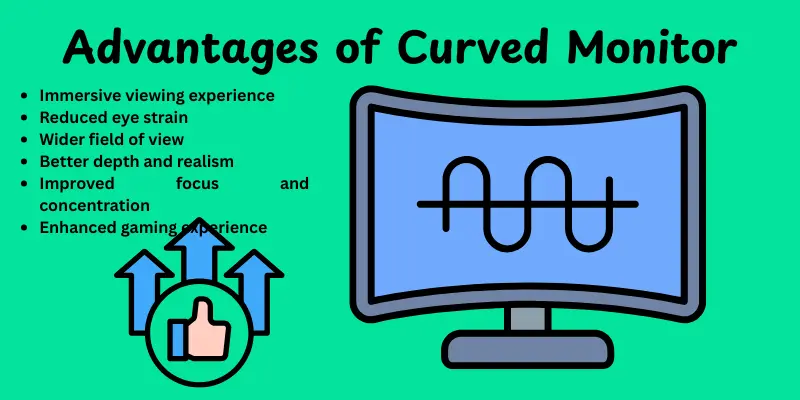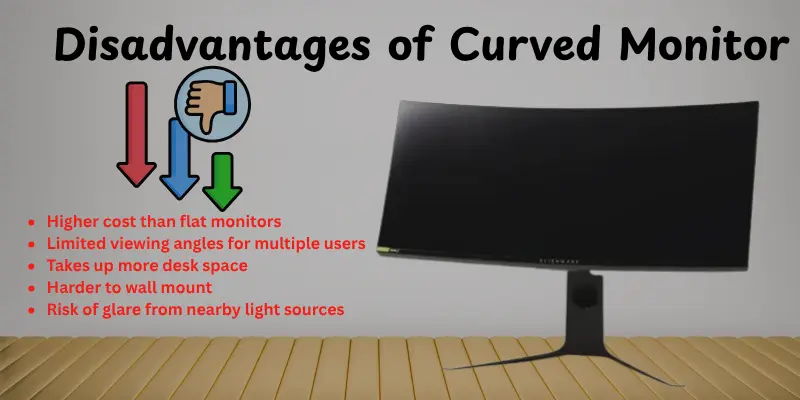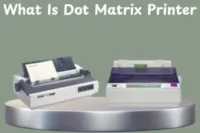Top Advantages and Disadvantages of Curved Monitor You Need to Know
Published: 22 Oct 2025
A curved monitor is a screen that curves slightly inside to look like the original shape of your eyes. It’s meant to provide a more enjoyable and engaging viewing experience than flat panels. But like with any technology, there are both benefits and drawbacks. Knowing both the advantages and disadvantages of curved monitors will help you determine if they are the best option for your setup. In this article, you’ll learn what makes these monitors unique, where they perform well, and what limitations to think about before purchasing one.
Advantages of Curved Monitor
Curved monitors provide many benefits over flat-screen displays. They improve the viewing experience by reducing eye strain and making games or movies feel more real. These screens also have greater viewing angles, making images look better from multiple angles. Overall, they’re great for both work and entertainment.Here are the main benefits of curved monitors:

- Immersive viewing experience
- Reduced eye strain
- Wider field of view
- Better depth and realism
- Improved focus and concentration
- Enhanced gaming experience
- Stylish and modern design
- More natural viewing angle
- Minimal image distortion at the edges
- Great for multitasking and productivity
- Better contrast and color consistency
- Comfort for long viewing sessions
1. Immersive Viewing Experience
A curved monitor pulls you into the action by wrapping the screen slightly around your eyes. This design makes pictures and videos look more real. It helps you to remain focused on what is in front of you instead of losing focus by your surrounds. You feel completely engaged in whatever you are doing, if it’s gaming or watching movies.
- Feels more natural and engaging
- Brings games and movies to life
- Keeps you focused on the screen
2. Reduced Eye Strain
Curved monitors follow the natural curve of your eyes, so you don’t need to move them as much. This helps reduce stress and fatigue during long use.The uniform distance between your eyes and the screen makes viewing easier and more pleasant. It’s perfect for people who spend long hours working or playing video games.
- Less eye movement needed
- Comfortable for long sessions
- Helps prevent tired or dry eyes
3. Wider Field of View
The curved shape provides a larger field of view than flat screens. It helps you to see more objects without rotating your head. This function is highly useful for multitasking and gaming. It provides a sense of depth that flat panels can’t duplicate.
- Covers more of your visual area
- Great for multitasking
- Adds depth and space to images
4. Better Depth and Realism
Curved displays make scenes appear more three-dimensional. The curved shape creates a feeling of depth, drawing you in. This impact is visible in games, movies, and design work. It makes pictures appear more realistic and vibrant.
- Adds a 3D-like feel
- Makes visuals look more real
- Improves the viewing experience
5. Improved Focus and Concentration
With a curved display, the eye naturally moves toward the center of the screen. This helps reduce distracting from your surroundings. It helps you stay focused on your job or game for a longer period of time. You may be productive without feeling clearly tired.
- Keeps your attention centered
- Reduces outside distractions
- Helps with long work or study sessions
6. Enhanced Gaming Experience
Gamers love curved monitors because they make games feel more intense. The screen surrounds your view, engaging you in the gaming environment. It improves motion flow and reduces distractions from screen edges. This setup increases both enjoyment and performance.
- Boosts game immersion
- Smooth, distraction-free play
- Feels more lifelike and exciting
7. Stylish and Modern Design
Curved displays give a clean, modern look to any work setting. Their unique design looks good and differs them from regular flat monitors. They often have slim edges and quality finishes. This makes them a popular choice for both home and business use.
- Looks elegant and unique
- Enhances workspace style
- Complements modern décor
8. More Natural Viewing Angle
The curved surface matches the shape of your eyes. This means you can view the full screen without straining or moving your position. It provides an even view from all angles. Watching or working is more natural and relaxing.
- Matches your eye’s shape
- Balanced screen visibility
- Reduces awkward viewing angles
9. Minimal Image Distortion at the Edges
Flat screens can stretch or distort pictures at the borders. Curved screens address this issue by maintaining all sections of the screen at the same distance from your eyes. This helps to retain image clarity and style. As a result, graphics look smooth and accurate through the screen.
- Keeps images clear at edges
- Reduces stretching and distortion
- Maintains consistent quality
10. Great for Multitasking and Productivity
Many curved monitors offer ultra-wide screens, which makes it simple to manage multiple windows at once. You can work on many things without switching displays. It’s ideal for editing, design, and data analysis. You keep organization and efficiency throughout the workday.
- Ideal for multitasking setups
- Saves time switching windows
- Boosts work efficiency
11. Better Contrast and Color Consistency
Curved monitors often provide more consistent color and brightness across the screen. The curved shape lets light reach your eyes equally. This results in deeper brightness and higher image quality. It is particularly useful for picture editing and video creation.
- Colors stay even across the screen
- Improves picture depth and quality
- Great for creative professionals
12. Comfort for Long Viewing Sessions
Curved panels are easy to use for long periods of time due to their natural design and equal light dispersion. Your eyes don’t have to work so hard to adjust. This makes them perfect for long work hours or gaming sessions. Even after lengthy use, you’ll feel less tired.
- Reduces eye fatigue
- Comfortable for long periods
- Perfect for daily computer users
Disadvantages of Curved Monitor
While curved displays have several benefits, they also have a few downsides. They are more expensive than flat displays and may not be suitable for all workspaces. Viewing from severe angles could alter the image, making it unsuitable for group uses. Understanding these downsides helps you decide if a curved monitor truly meets your needs.Here are the main drawbacks of curved monitors:

- Higher cost than flat monitors
- Limited viewing angles for multiple users
- Takes up more desk space
- Harder to wall mount
- Risk of glare from nearby light sources
- Not ideal for precise design work
- Can cause slight image distortion
- Fewer size and budget options
- Heavier and bulkier design
- Not suitable for multi-screen arrangements
- May require a larger desk setup
- Some models have limited compatibility with monitor arms
1. Higher Cost Than Flat Monitors
Curved monitors are normally more expensive due to their outstanding shape and display technology. The curved panel and specific manufacturing method increase the cost. This makes them less affordable for casual users. If you want quality, be prepared to spend more.
- More expensive than flat monitors
- Not ideal for tight budgets
- Costs rise with size and features
2. Limited Viewing Angles for Multiple Users
Curved displays are best viewed in the middle. When people watch from the side, the image may look distorted or darker. This makes them unsuitable for sharing content with others. They perform well for personal use but not for group viewing.
- Poor visibility from side angles
- Not ideal for group work
- Best for one-person use
3. Takes Up More Desk Space
Because of their curved shape and larger size, these monitors require more desk space. They usually extend further back, requiring a larger table. This might be a problem in small or crowded work spaces. You will need to carefully arrange your setup.
- Needs extra desk depth
- Not suitable for small desks
- Limits space for other accessories
4. Harder to Wall Mount
A curved monitor requires more effort to mount on the wall than a flat panel. This bend may cause gaps or uneven spacing against the wall. You can need specific mounts or brackets to make it fit correctly. This may raise setup costs and effort.
- Requires special mounting tools
- May not sit flush on walls
- Adds setup difficulty and expense
5. Risk of Glare from Nearby Light Sources
Curved screens are better at catching reflections from lights and windows. The curved surface may reflect light into your eyes. This can have an impact on viewing comfort, particularly in brightly lit settings. This problem can be minimized by using proper light.
- Reflects nearby light
- Can strain the eyes in bright rooms
- Needs careful light placement
6. Not Ideal for Precise Design Work
Curved displays may produce small distortions when performing jobs that need exact lines or measurements. This might make straight lines and design patterns appear somewhat curved. Designers and architects frequently choose flat displays for accuracy. It isn’t an issue for casual use, still.
- May distort straight lines
- Not perfect for editing or CAD work
- Flat screens offer better precision
7. Can Cause Slight Image Distortion
Depending on the screen curve, certain photos may look slightly stretched or curved. This occurs primarily on ultra-wide models. When not always apparent it can be disturbing in certain situations. Flat displays often maintain visual proportions more constant.
- Slight stretching at edges
- Noticeable on ultra-wide screens
- May affect image accuracy
8. Fewer Size and Budget Options
Curved panels come in less sizes than flat monitors. Smaller variants are common, and ultra-wide ones can be expensive. This limits your options if you’re searching for something basic and inexpensive. The majority of curved screens target at premium customers.
- Fewer small-screen models
- Limited options for low budgets
- Aimed at premium markets
9. Heavier and Bulkier Design
Curved displays often weigh more due to extra structure and curve support. This makes them difficult to move or alter. In addition, the stand takes up extra desk space. If you want to change your setup frequently, it might be challenging.
- Heavier than flat screens
- Harder to reposition
- Takes up more desk area
10. Not Suitable for Multi-Screen Arrangements
Using many curved displays side by side might be challenging. The curves can meet, resulting in gaps or unusual angles between displays. This arrangement may not usually line as cleanly as flat panels. It is preferable to use one huge curved screen instead.
- Hard to align multiple monitors
- Creates visual gaps
- Best for single-monitor setups
11. May Require a Larger Desk Setup
Curved displays, particularly ultra-wide ones, require plenty of room. They can crowd smaller desks or workspaces. If your desk is narrow, you may feel stuck. Always measure your room before buying one.
- Needs a wide desk area
- Crowds smaller workspaces
- Limits placement options
12. Some Models Have Limited Compatibility with Monitor Arms
Not all monitor arms are designed for curved displays. The curvature and weight might make installation difficult. You may require a strong, adjustable arm that matches the shape and size. This could boost the total cost and setup time.
- Not all arms support curved models
- May require special mounts
- Increases setup cost and effort
Conclusion
Curved monitors provide a mix of exciting pros and practical cons. We’ve looked at how they improve enjoyment, reduce eye strain, and increase attention, but they may also be expensive and take up more room. Knowing all sides helps you to make an informed and equal choice depending on your personal situation. Each setup is unique, so what works for one person may not work for another. Think carefully before selecting the monitor that best suits your style and workspace.
FAQs
No, curved displays aren’t risky to use. They function similarly to flat displays, but in a different shape. The curve doesn’t harm your eyes or affect your eyesight. Just make sure you sit at the proper distance to take full use of the curve.
Not really, but they can be more sensitive in some situations. Because of their shape, they are difficult to replace or repair if damaged. The screen itself is not weaker; it simply requires more care when moving or cleaning. Handle it gently, and it will last just as long as a flat display.
Curved monitors provide a more natural, immersive viewing experience. They reduce eye strain and make movies or games more realistic. You also receive a larger field of view, which improves your focus. Many people enjoy how beautiful and modern they look on a desk.
Curved displays can be more expensive and need extra space. They are not ideal for group viewing since pictures might distort from various angles. It can also be difficult to mount them on walls. However, for personal use they provide excellent comfort and focus.
Yes, especially for tasks that need focus, like editing or multitasking. The curved shape keeps your eyes centered and reduces distractions. It’s also easier to view wide spreadsheets or multiple windows. Just make sure you have enough desk space for the monitor’s curve.
Yes, curved monitors generally last just as long as flat ones. Their lifespan depends more on quality and care than shape. As long as you keep them clean and handle them carefully, they’ll serve you for years. Just avoid dropping or pressing on the curved surface.

- Be Respectful
- Stay Relevant
- Stay Positive
- True Feedback
- Encourage Discussion
- Avoid Spamming
- No Fake News
- Don't Copy-Paste
- No Personal Attacks

- Be Respectful
- Stay Relevant
- Stay Positive
- True Feedback
- Encourage Discussion
- Avoid Spamming
- No Fake News
- Don't Copy-Paste
- No Personal Attacks





